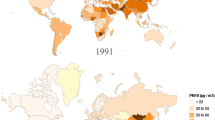Abstract
The effects of mesoscale meteorological phenomena on the transport of pollutants were analyzed by 3-dimensional dispersion calculations in case of a hypothetical nuclear accident. The results were in agreement with the earlier results obtained by Kestiet al. (1988) clearly indicating the importance of mesocale meteorological phenomena in short-range dispersion of pollutants.
Similar content being viewed by others
References
Deutche Risikostudie Kernkraftwerke- (1979):Eine Untersuchung zu dem durch Stofälle in kerkraftwerken verursachten Risiko. Bonnr, der Bundesminister fur Forschung und Technologie. 262 p.
Jylhä K., 1991:Empirical scavenging coefficients of radioactive substances released from Chernobyl, Atmospheric Environment, vol 25A, No. 2, 263–270.
Kaurola J., Koistinen J., Leskinen M., Puhakka T. and Saarikivi P., 1992:The Effect of Mesometeorological Factors on the Dispersion of Pollutants, Especially on the Coast of the Gulf of Finland, Part III, Abundance of Mesoscale Phenomena in the Southern Part of Finland and the Possibilities of Doppler-radar to Detect the Phenomena, University of Helsinki, Department of Meteorology, Helsinki 1989, in Finnish, to be published in English.
Kesti P., Jylhä K., Koistinen J., Puhakka T. and Saarikivi P., 1988:The Effect of Mesometeorological Factors on the Dipersion of Pollutants, Especially on the Coast of the Gulf of Finland, Part II, Estimation Errors Caused by Mesoscale Phenomena, University of Helsinki, Department of Meteorology, 58 p., in Finnish, to be published in English.
Kesti P., Puhakka T., Jylhä K., Koistinen J. and Saarikivi P., 1987:The Effect of Mesometeorological Factors on the Dispersion of Pollutants, Especialy on the Coast of the Gulf of Finland, Part I, the Wind and Rain Fields Associated with Some Mesoscale phenomena, University of Helsinki, Department of Meteorology, 54 p., in Finnish, to be published in English.
Puhakka T., Jylhä K., Saarikivi P., Koistinen J. and Koivukoski J., 1988:Meteorological Factors Influencing the Radioactive Deposition in Finland after the Chernobyl Accident, Report 29, Department of Meteorology, University of Helsinki, 49 p.
Rantalainen L., 1988:The external dose caused by the release of radioactive noble gases from the nuclear power plant, AMAPI, Thesis for Lic. Tech., Helsinki University of Technology, 118p.
Saikkonen T., 1991:A calculation model TUULET to estimate the doses caused by the radioactive releases, Imatran Voima Oy, DY1-G710-0035, In Finnish.
Slade D.H., Editor, 1969.Meteorology and atomic energy U.S. Atomic Energy Commission, Division of Technical Information, Oak Ridge, 445 p.
Vuori S., 1978:Fast Correction of Cloud Dose data Files Due to Chance in Dispersion Parameters, Health Physics, vol. 34, June, Pergamon Press Ltd., 727–730.
Author information
Authors and Affiliations
Rights and permissions
About this article
Cite this article
Rantalainen, L. The importance of mesoscale phenomena on the dispersion of pollutants in the vicinity of a point-source emission. Boundary-Layer Meteorol 62, 143–150 (1993). https://doi.org/10.1007/BF00705551
Received:
Issue Date:
DOI: https://doi.org/10.1007/BF00705551




